Related Research Articles

The Wadiyar dynasty, is a late-medieval/early-modern South Indian Hindu royal family of former kings of Mysore from the Urs clan originally based in Mysore city.

Chamarajendra Wadiyar X was the twenty-third Maharaja of Mysore between 1868 and 1894.

Mysore Palace, also known as Amba Vilas Palace, is a historical palace and a royal residence (house). It is located in Mysore, Karnataka, India. It used to be the official residence of the Wadiyar dynasty and the seat of the Kingdom of Mysore. The palace is in the centre of Mysore, and faces the Chamundi Hills eastward. Mysore is commonly described as the 'City of the Palaces', and there are seven palaces including this one. However, the Mysore Palace refers specifically to the one within the new fort.
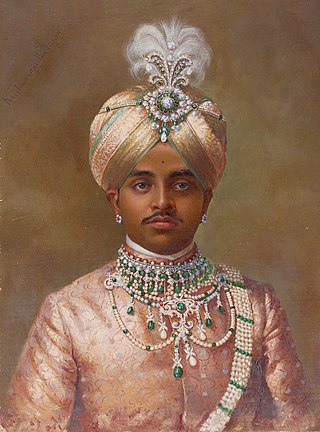
Krishnaraja Wadiyar IV (Kannada: ಶ್ರೀ ನಾಲ್ವಡಿ ಕೃಷ್ಣರಾಜ ಒಡೆಯರು; 4 June 1884 – 3 August 1940) was the twenty-fourth Maharaja of Mysore, reigning from 1902 until his death in 1940.

The maharaja of Mysore was the king and principal ruler of the southern Indian Kingdom of Mysore and briefly of Mysore State in the Indian Dominion roughly between the mid- to late-1300s and 1950. The maharaja's consort was called the maharani of Mysore.
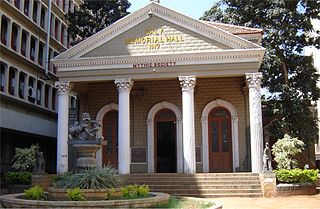
The Daly Memorial Hall, is a heritage building located in Bangalore, Karnataka that houses the Mythic Society. The Mythic society, founded in 1909, is a pioneering institution of Catholic-Indic studies in South India. Daly Memorial Hall, built at a cost of INR 24,783, was inaugurated on 25 July 1917 by the Kanteerava Narasimharaja Wadiyar (the Yuvaraja of Mysore. The Hall is named after Sir Hugh Daly, who served as the Resident of Mysore State and Chief Commissioner of Coorg.
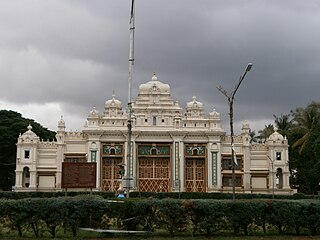
Sri Jayachamarajendra Art Gallery, commonly known by its former name Jaganmohana Palace, is a royal mansion, arts museum and auditorium, and formerly an alternative royal residence of the ruling maharaja of Mysore, located in Mysore, India, about 200m (600ft) to the west of Mysore Palace. Began in 1856 and completed in 1861, the palace is one of the oldest modern structures in Mysore.

Krishnaraja Wadiyar III was the twenty-second maharaja of the Kingdom of Mysore. Also known as Mummadi Krishnaraja Wadiyar, the maharaja belonged to the Wadiyar dynasty and ruled the kingdom for nearly seventy years, from 30 June 1799 to 27 March 1868. He is known for his contribution and patronage to different arts and music during his reign. He was succeeded by his adopted son, Chamarajendra Wadiyar X.

KrishnacharyaPurnaiah, popularly known as DewanPurnaiah, was an Indian administrator, statesman, and strategist who served as the first dewan of Mysore from 1782 to 1811. He was instrumental in the restoration of the rule of the Kingdom of Mysore to the Wadiyar dynasty. After the death of Tipu, he continued to advice Lakshmi Devi, the queen regent to the newly installed monarch Krishnaraja Wodeyar III.
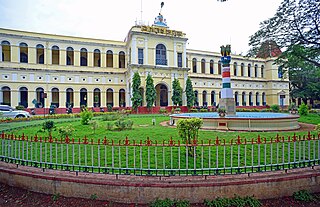
Maharaja's College, Mysore (1889) is a college affiliated to Mysore University.

SirTanjore Ananda Rao was an Indian administrator and statesman who served as the 18th Diwan of Mysore from 1909 to 1912. He was the eldest son of Sir T. Madhava Rao.
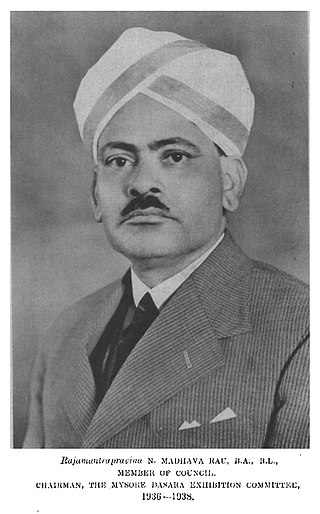
SirNyapathi Madhava Rau was an Indian civil servant, administrator, and statesman who served as the 23rd dewan of Mysore from 1941 to 1945 and later as a member of the Drafting Committee of the Constituent Assembly which drafted the Indian Constitution.
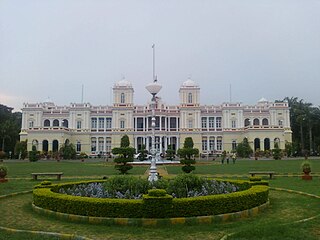
Cheluvamba Mansion is located in the city of Mysore, Karnataka. It was built by Maharaja Krishnaraja Wodeyar IV for the third princess of Mysore - Cheluvajammanni and it is similar to other mansions built by them which are spread over a large area surrounded by gardens. This mansion is crafted like other buildings of the Wadiyar dynasty.
The dewan of Mysore, sometimes spelled Diwan of Mysore, was the de facto chief executive officer of the Government of Mysore, ex officio chairman of the Dewan's Council, and the prime minister and royal adviser to the maharaja of Mysore. The role evolved in title and duties since the foundation of the fiefdom of Mysore in 1350 and its proper reformation into a kingdom in the following centuries until the kingdom's full abolishment in 1950. With the constitution of India into a republic in 1950, the position was replaced by Chief Minister of Mysore.
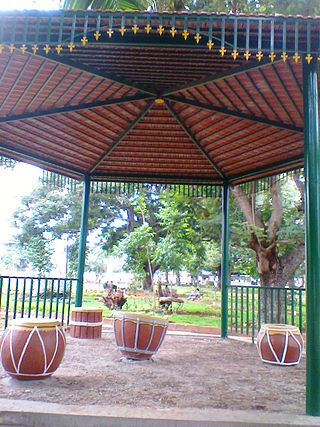
Ballal Circle, officially known as Ashoka Circle, is one of the major traffic junction in Mysore city, Karnataka state, India.

Krishnaraja Assembly constituency is one of the 224 constituencies in the Karnataka Legislative Assembly of Karnataka with having all the areas under the zone of Mysore south such as Ashokapuram, Vidyaranyapuram, JP Nagar, Srirampura, Mysore Palace, Agrahara, KR circle, and Vishweranagara. It is also part of Mysore Lok Sabha constituency.

Krishnaraja Boulevard is an important street of Mysore city in Karnataka state of India.

Chamarajapuram is one of the earliest settlements and localities in Mysore, Karnataka, India, located in the centre of Mysore city. Initially an agraharam inhabited by the Mysore nobility, parts of it were later allotted other local dwellers as well.
Agrahara is an area of the city of Mysore in the state of Karnataka in India. Famous locations in Agrahara include Mysore Palace as well as several gardens and historic temples. The area is bounded by Albert Victor Road to the North, MG Road to the South, Bengaluru-Nilgiri Road to the East, and Cheluvamba Agrahara Road to the West. The term agrahara or agraharam refers to a grant of land and agricultural income made by royalty to Brahmins in pre-independence South India. Though the Mysuru Agrahara is commonly referred to as a single neighbourhood, it is a composite of multiple adjacent smaller settlements built over time.
Mirza Road is a road in Mysore city, Karnataka state, India.
References
- ↑ "Ashoka Circle (Ballal Circle) - Mysuru".
- ↑ "Novel drinking water campaign for birds launched in city". Star of Mysore. 31 March 2018. Retrieved 1 March 2022.
- ↑ "Citizens stage unique protest". Star of Mysore. 19 May 2019. Retrieved 1 March 2022.
- ↑ "Overflowing manhole near Agrahara Circle". Star of Mysore. 28 July 2017. Retrieved 1 March 2022.
- ↑ "SUCI opposes abolition of subsidy on LPG". Star of Mysore. 13 August 2017. Retrieved 1 March 2022.
- ↑ "Excessive consumption of liquor claims man's life". Star of Mysore. 7 February 2017. Retrieved 1 March 2022.
- ↑ "How Mummadi and his Queens built Mysore". Star of Mysore. 16 February 2020. Retrieved 1 March 2022.
- ↑ Kadati Reddera Basavaraja (1984). History and Culture of Karnataka: Early Times to Unification. Chalukya Publications. p. 334.
- ↑ "Landmarks for Dewans and their services forgotten". Star of Mysore. 2 November 2020. Retrieved 1 March 2022.
- ↑ "Two-wheelers damaged as tree branch falls near Agrahara Circle". Star of Mysore. 15 October 2020. Retrieved 1 March 2022.
12°17′53″N76°39′07″E / 12.29795142822711°N 76.65181431219148°E